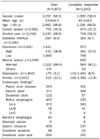1. Talley NJ, Silverstein MD, Agréus L, Nyrén O, Sonnenberg A, Holtmann G. American Gastroenterological Association. AGA technical review: evaluation of dyspepsia. Gastroenterology. 1998. 114:582–595.
2. Lam SK, Talley NJ. Report of the 1997 Asia Pacific Consensus Conference on the management of Helicobacter pylori infection. J Gastroenterol Hepatol. 1998. 13:1–12.
3. Kim JS, Lee KJ, Kim JH, Hahm KB, Cho SW. Functional gastrointestinal disorders in patients referred to specialist gastroenterologists in a tertiary hospital. Korean J Neurogastroenterol Motil. 2004. 10:111–117.
4. Talley NJ, Vakil NB, Moayyedi P. American gastroenterological association technical review on the evaluation of dyspepsia. Gastroenterology. 2005. 129:1756–1780.
5. Veldhuyzen van Zanten SJ, Bradette M, Chiba N, et al. Canadian Dyspepsia Working Group. Evidence-based recommendations for short- and long-term management of uninvestigated dyspepsia in primary care: an update of the Canadian Dyspepsia Working Group (CanDys) clinical management tool. Can J Gastroenterol. 2005. 19:285–303.
6. Kim JI, Kim SG, Kim N, et al. Korean College of Helicobacter and Upper Gastrointestinal Research. Changing prevalence of upper gastrointestinal disease in 28 893 Koreans from 1995 to 2005. Eur J Gastroenterol Hepatol. 2009. 21:787–793.
7. Jung HK, Na YJ, Moon IH. Changes of helicobacter pylori-positive peptic ulcer disease: based on data from a general hospital. Korean J Gastrointest Endosc. 2006. 32:1–8.
8. Han CH, Lee JS, Ahn JO, et al. The meaning of warning symptoms in the patients with dyspepsia. Korean J Med. 2007. 73:25–33.
9. Vakil N, Moayyedi P, Fennerty MB, Talley NJ. Limited value of alarm features in the diagnosis of upper gastrointestinal malignancy: systematic review and meta-analysis. Gastroenterology. 2006. 131:390–401.
10. Talley NJ, Phillips SF, Melton J 3rd, Wiltgen C, Zinsmeister AR. A patient questionnaire to identify bowel disease. Ann Intern Med. 1989. 111:671–674.
11. Talley NJ, Phillips SF, Wiltgen CM, Zinsmeister AR, Melton LJ 3rd. Assessment of functional gastrointestinal disease: the bowel disease questionnaire. Mayo Clin Proc. 1990. 65:1456–1479.
12. Song HJ, Jung HK, Yeom HJ, et al. Reliability and validity of Korean bowel disease questionnaire and prevalence of functional gastrointestinal disorders in Korea. Gut. 2009. 58:Suppl 1. A112.
13. Lundell LR, Dent J, Bennett JR, et al. Endoscopic assessment of oesophagitis: clinical and functional correlates and further validation of the Los Angeles classification. Gut. 1999. 45:172–180.
14. Sharma P, McQuaid K, Dent J, et al. AGA Chicago Workshop. A critical review of the diagnosis and management of Barrett's esophagus: the AGA Chicago Workshop. Gastroenterology. 2004. 127:310–330.
15. Correa P. Chronic gastritis: a clinico-pathological classification. Am J Gastroenterol. 1988. 83:504–509.
16. Dooley CP, Cohen H, Fitzgibbons PL, et al. Prevalence of Helicobacter pylori infection and histologic gastritis in asymptomatic persons. N Engl J Med. 1989. 321:1562–1566.
17. Tack J, Talley NJ, Camilleri M, et al. Functional gastroduodenal disorders. Gastroenterology. 2006. 130:1466–1479.
18. Barkun A, Leontiadis G. Systematic review of the symptom burden, quality of life impairment and costs associated with peptic ulcer disease. Am J Med. 2010. 123:358–366.
19. Zagari RM, Law GR, Fuccio L, Pozzato P, Forman D, Bazzoli F. Dyspeptic symptoms and endoscopic findings in the community: the Loiano-Monghidoro study. Am J Gastroenterol. 2010. 105:565–571.







 PDF
PDF ePub
ePub Citation
Citation Print
Print




 XML Download
XML Download